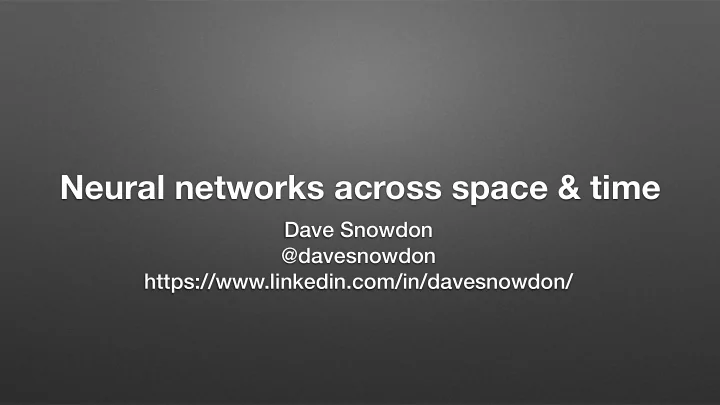

Neural networks across space & time Dave Snowdon @davesnowdon https://www.linkedin.com/in/davesnowdon/
About me • Java & javascript by day • Python & clojure by night • Amateur social roboticist • Been learning about deep learning for 18 months
Agenda • Why neural networks • How do neural networks work • Convolutional neural networks • Recurrent neural networks
Why neural networks?
Why care about deep learning? • Impressive results in a wide range of domains • image classification, text descriptions of images, language translation, speech generation, speech recognition… • Predictable execution (inference) time • Amenable to hardware acceleration • Automatic feature extraction
What are features? Average statement length Number of variables 10 PRINT “Hello QCon London” 20 GOTO 10 Number of statements Cyclomatic complexity
Feature extraction Traditional machine learning process Pre- Extract Data Model Results features process Deep learning process Pre- Data Model Results process
Neural network downsides • Need to define the model and it’s training parameters • Large models can take days or weeks to train • May need a lot of data. > 10K examples
How neural networks work
Deep learning != your brain NOT YOUR NEURAL NETWORK
Neuron model bias (weight for fixed input) b input 0 x 0 w 0 weight 0 weight 1 w 1 S S input 1 x 1 u u F( ) output m m weight N w N input N x N
Neuron model 0.8 0.5 0.1 -0.5 S 1 -1.65 F( ) u m 4 -0.5
Neuron model 0.8 identity 0.5 0.1 -0.5 S 1 -1.65 F( ) u -1.65 m 4 -0.5
Neuron model 0.8 sigmoid 0.5 0.1 -0.5 S 1 -1.65 F( ) u 0.1611 m 4 -0.5
Neuron model 0.8 tanh 0.5 0.1 -0.5 S 1 -1.65 F( ) u -0.9289 m 4 -0.5
Neuron model 0.8 ReLU 0.5 0.1 -0.5 S 1 -1.65 F( ) u 0 m 4 -0.5
Neural networks are not graphs
Neural networks are like onions (they have layers and can make you cry) Input layer Hidden layer Output layer
Why layers? x x x x x Layer 1 Layer 2
Neural networks are like onions (they have layers and can make you cry) W 2 W 1 � � W W W W � � 11 12 13 14 ⎧ ⎫ � � W 11 W 12 W 13 W W W W ⎪ ⎪ � � 21 22 23 24 � � ⎪ ⎪ W 21 W 22 W 23 ⎪ ⎪ ⎨ ⎬ W 31 W 32 W 33 ⎪ ⎪ ⎪ ⎪ Input layer output = f(W 2 . f(W 1 . Input + B 1 ) + B 2 ) Hidden layer Output layer W 41 W 42 W 43 ⎪ ⎪ ⎩ ⎭
Going deeper Input layer Hidden layer Hidden layer Output layer
What do the layers do? Successive layers model higher level features
What input can a network accept? • Anything you like as long as it’s a tensor • Tensor = general multi-dimensional numeric quantity • scalar = tensor of 0 dimensions (AKA rank 0) • vector = 1 dimensional tensor (rank 1) • matrix = 2 dimensional tensor (rank 2) • tensor = N dimensional tensor (rank > 2)
Images Can represent image as tensor of rank 3 Source: https://www.slideshare.net/BertonEarnshaw/a-brief-survey-of-tensors
One-hot encoding : input “enums” FAVOURITE PROGRAMMING LANGUAGE JAVA CLOJURE PYTHON JAVASCRIPT 1 0 0 0 BARRY 0 1 0 0 BRUCE RUSSEL 0 0 1 0
One-hot encoding: output Also useful for output Probability distribution JAVA CLOJURE PYTHON JAVASCRIPT 0.6 0.1 0.1 0.2 BARRY 0.15 0.75 0.05 0.05 BRUCE RUSSEL 0.34 0.05 0.6 0.01
Back propagation Input example Training example Expected output Cost Error Function (also known as cost or loss) ⎛ ⎛ ⎞ ⎞ w 11 w 11 w 12 w 12 ⎜ ⎜ ⎟ ⎟ ⎛ ⎞ ⎛ ⎞ ⎜ ⎜ ⎟ ⎟ w 21 w 22 w 21 w 22 w 11 w 11 w 12 w 12 w 13 w 13 w 14 w 14 ⎜ ⎟ ⎜ ⎟ ⎜ ⎟ ⎜ ⎟ ⎜ ⎟ ⎜ ⎟ w 31 w 32 w 31 w 32 ⎜ ⎜ ⎟ ⎟ w 21 w 21 w 22 w 22 w 23 w 23 w 24 w 24 ⎜ ⎟ ⎜ ⎟ ⎜ ⎟ ⎜ ⎟ ⎜ ⎟ ⎜ ⎟ ⎜ ⎟ w 41 w 42 w 41 w 42 ⎜ ⎟ w 31 w 31 w 32 w 32 w 33 w 33 w 34 w 34 ⎝ ⎠ ⎝ ⎠ ⎝ ⎝ ⎠ ⎠
More on back propagation
Frameworks
Summary so far • Neural networks are NOT like your brain • Networks are arranged as layers • Forward pass compute output of network • Backward pass compute gradients & adjust weights • Frameworks take care of the math for you • but still good to understand what’s going on
A request from marketing
Images that mention VMware
First we need a dataset
Highlight the parts for training
Creating the dataset • Grab images from google image search • PyImageSearch “How to create a deep learning dataset using Google Images” • Use dlib imglab tool to draw bounding boxes around logos / not Logos • https://github.com/davisking/dlib/tree/master/tools/imglab • Wrote python script to read imglab XML and produce cropped images using OpenCV
Sliding windows
Multiple scales
How it all adds up • 5501 images total • 883 VMware • 4318 not VMware • Scaled to 75x22x3 -> 4950 inputs • Easily 4,950,000 weights in first layer alone • Maybe we need another neural network architecture
Convolutional Neural Networks
Convolution
Convolution example(s) 1 0 -1 1 1 1 -1 -1 -1 1 0 -1 0 0 0 -1 8 -1 1 0 -1 -1 -1 -1 -1 -1 -1
Convolutional layer
Max Pooling layer
Convolutional network
DL4J model structure Convolution Convolution Fully connected Softmax Pooling Input Pooling
Recommend
More recommend